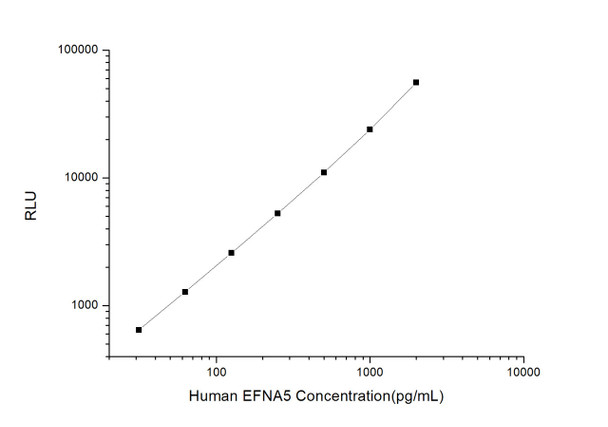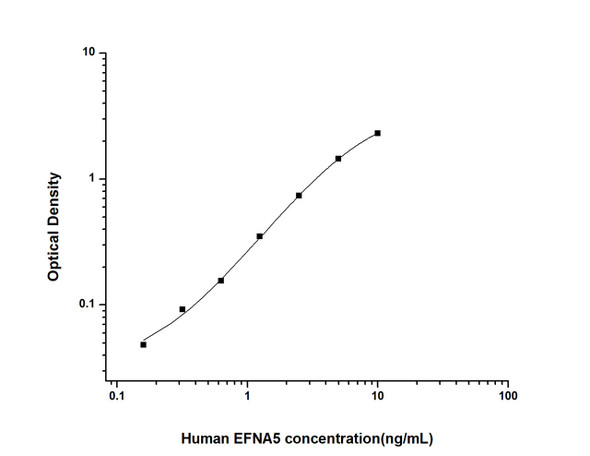Human Developmental Biology ELISA Kits
Human EFNA5 (Ephrin A5) CLIA Kit (HUES00663)
- SKU:
- HUES00663
- Product Type:
- ELISA Kit
- ELISA Type:
- CLIA Kit
- Size:
- 96 Assays
- Sensitivity:
- 18.75pg/mL
- Range:
- 31.25-2000pg/mL
- ELISA Type:
- Sandwich
- Reactivity:
- Human
- Sample Type:
- Serum, plasma and other biological fluids
- Research Area:
- Developmental Biology
Description
| Assay type: | Sandwich |
| Format: | 96T |
| Assay time: | 4.5h |
| Reactivity: | Human |
| Detection method: | Chemiluminescence |
| Detection range: | 31.25-2000 pg/mL |
| Sensitivity: | 18.75 pg/mL |
| Sample volume: | 100µL |
| Sample type: | Serum, plasma and other biological fluids |
| Repeatability: | CV < 15% |
| Specificity: | This kit recognizes Human EFNA5 in samples. No significant cross-reactivity or interference between Human EFNA5 and analogues was observed. |
This kit uses Sandwich-CLIA as the method. The micro CLIA plate provided in this kit has been pre-coated with an antibody specific to Human EFNA5. Standards or samples are added to the appropriate micro CLIA plate wells and combined with the specific antibody. Then a biotinylated detection antibody specific for Human EFNA5 and Avidin-Horseradish Peroxidase (HRP) conjugate are added to each micro plate well successively and incubated. Free components are washed away. The substrate solution is added to each well. Only those wells that contain Human EFNA5, biotinylated detection antibody and Avidin-HRP conjugate will appear fluorescence. The Relative light unit (RLU) value is measured spectrophotometrically by the Chemiluminescence immunoassay analyzer. The RLU value is positively associated with the concentration of Human EFNA5. The concentration of Human EFNA5 in the samples can be calculated by comparing the RLU of the samples to the standard curve.
| UniProt Protein Function: | EFNA5: Cell surface GPI-bound ligand for Eph receptors, a family of receptor tyrosine kinases which are crucial for migration, repulsion and adhesion during neuronal, vascular and epithelial development. Binds promiscuously Eph receptors residing on adjacent cells, leading to contact-dependent bidirectional signaling into neighboring cells. The signaling pathway downstream of the receptor is referred to as forward signaling while the signaling pathway downstream of the ephrin ligand is referred to as reverse signaling. Induces compartmentalized signaling within a caveolae-like membrane microdomain when bound to the extracellular domain of its cognate receptor. This signaling event requires the activity of the Fyn tyrosine kinase. Activates the EPHA3 receptor to regulate cell-cell adhesion and cytoskeletal organization. With the receptor EPHA2 may regulate lens fiber cells shape and interactions and be important for lens transparency maintenance. May function actively to stimulate axon fasciculation. The interaction of EFNA5 with EPHA5 also mediates communication between pancreatic islet cells to regulate glucose-stimulated insulin secretion. Cognate/functional ligand for EPHA7, their interaction regulates brain development modulating cell-cell adhesion and repulsion. Belongs to the ephrin family. |
| UniProt Protein Details: | Protein type:Cell development/differentiation; Ligand, receptor tyrosine kinase; Motility/polarity/chemotaxis; Membrane protein, GPI anchor Chromosomal Location of Human Ortholog: 5q21 Cellular Component: anchored to external side of plasma membrane; extracellular region; plasma membrane; caveola Molecular Function:ephrin receptor binding; chemorepellent activity Biological Process: nervous system development; axon guidance; positive regulation of peptidyl-tyrosine phosphorylation; regulation of cell-cell adhesion; apoptosis; regulation of actin cytoskeleton organization and biogenesis; regulation of focal adhesion formation; ephrin receptor signaling pathway; negative chemotaxis; retinal ganglion cell axon guidance |
| NCBI Summary: | Ephrin-A5, a member of the ephrin gene family, prevents axon bundling in cocultures of cortical neurons with astrocytes, a model of late stage nervous system development and differentiation. The EPH and EPH-related receptors comprise the largest subfamily of receptor protein-tyrosine kinases and have been implicated in mediating developmental events, particularly in the nervous system. EPH receptors typically have a single kinase domain and an extracellular region containing a Cys-rich domain and 2 fibronectin type III repeats. The ephrin ligands and receptors have been named by the Eph Nomenclature Committee (1997). Based on their structures and sequence relationships, ephrins are divided into the ephrin-A (EFNA) class, which are anchored to the membrane by a glycosylphosphatidylinositol linkage, and the ephrin-B (EFNB) class, which are transmembrane proteins. The Eph family of receptors are similarly divided into 2 groups based on the similarity of their extracellular domain sequences and their affinities for binding ephrin-A and ephrin-B ligands. [provided by RefSeq, Jul 2008] |
| UniProt Code: | P52803 |
| NCBI GenInfo Identifier: | 1706678 |
| NCBI Gene ID: | 1946 |
| NCBI Accession: | P52803. 1 |
| UniProt Related Accession: | P52803 |
| Molecular Weight: | 26,297 Da |
| NCBI Full Name: | Ephrin-A5 |
| NCBI Synonym Full Names: | ephrin-A5 |
| NCBI Official Symbol: | EFNA5 |
| NCBI Official Synonym Symbols: | AF1; EFL5; RAGS; EPLG7; GLC1M; LERK7 |
| NCBI Protein Information: | ephrin-A5; AL-1; LERK-7; eph-related receptor tyrosine kinase ligand 7 |
| UniProt Protein Name: | Ephrin-A5 |
| UniProt Synonym Protein Names: | AL-1; EPH-related receptor tyrosine kinase ligand 7; LERK-7 |
| Protein Family: | Ephrin |
| UniProt Gene Name: | EFNA5 |
| UniProt Entry Name: | EFNA5_HUMAN |
As the RLU values of the standard curve may vary according to the conditions of the actual assay performance (e. g. operator, pipetting technique, washing technique or temperature effects), the operator should establish a standard curve for each test. Typical standard curve and data is provided below for reference only.
| Concentration (pg/mL) | RLU | Average | Corrected |
| 2000 | 54785 56657 | 55721 | 55693 |
| 1000 | 23844 24104 | 23974 | 23946 |
| 500 | 11737 10327 | 11032 | 11004 |
| 250 | 4966 5622 | 5294 | 5266 |
| 125 | 2707 2509 | 2608 | 2580 |
| 62.5 | 1343 1279 | 1311 | 1283 |
| 31.25 | 657 691 | 674 | 646 |
| 0 | 27 29 | 28 | -- |
Precision
Intra-assay Precision (Precision within an assay): 3 samples with low, mid range and high level Human EFNA5 were tested 20 times on one plate, respectively.
Inter-assay Precision (Precision between assays): 3 samples with low, mid range and high level Human EFNA5 were tested on 3 different plates, 20 replicates in each plate.
| Intra-assay Precision | Inter-assay Precision | |||||
| Sample | 1 | 2 | 3 | 1 | 2 | 3 |
| n | 20 | 20 | 20 | 20 | 20 | 20 |
| Mean (pg/mL) | 104.75 | 308.40 | 967.24 | 94.66 | 332.85 | 951.96 |
| Standard deviation | 8.99 | 28.87 | 61.90 | 8.07 | 31.19 | 85.20 |
| C V (%) | 8.58 | 9.36 | 6.40 | 8.53 | 9.37 | 8.95 |
Recovery
The recovery of Human EFNA5 spiked at three different levels in samples throughout the range of the assay was evaluated in various matrices.
| Sample Type | Range (%) | Average Recovery (%) |
| Serum (n=5) | 101-115 | 108 |
| EDTA plasma (n=5) | 88-100 | 95 |
| Cell culture media (n=5) | 86-96 | 91 |
Linearity
Samples were spiked with high concentrations of Human EFNA5 and diluted with Reference Standard & Sample Diluent to produce samples with values within the range of the assay.
| Serum (n=5) | EDTA plasma (n=5) | Cell culture media (n=5) | ||
| 1:2 | Range (%) | 90-105 | 87-100 | 88-100 |
| Average (%) | 96 | 93 | 93 | |
| 1:4 | Range (%) | 98-114 | 94-108 | 97-114 |
| Average (%) | 104 | 102 | 105 | |
| 1:8 | Range (%) | 104-119 | 90-106 | 94-107 |
| Average (%) | 110 | 98 | 100 | |
| 1:16 | Range (%) | 97-109 | 92-108 | 86-100 |
| Average (%) | 103 | 99 | 91 |
An unopened kit can be stored at 4°C for 1 month. If the kit is not used within 1 month, store the items separately according to the following conditions once the kit is received.
| Item | Specifications | Storage |
| Micro CLIA Plate(Dismountable) | 8 wells ×12 strips | -20°C, 6 months |
| Reference Standard | 2 vials | |
| Concentrated Biotinylated Detection Ab (100×) | 1 vial, 120 µL | |
| Concentrated HRP Conjugate (100×) | 1 vial, 120 µL | -20°C(shading light), 6 months |
| Reference Standard & Sample Diluent | 1 vial, 20 mL | 4°C, 6 months |
| Biotinylated Detection Ab Diluent | 1 vial, 14 mL | |
| HRP Conjugate Diluent | 1 vial, 14 mL | |
| Concentrated Wash Buffer (25×) | 1 vial, 30 mL | |
| Substrate Reagent A | 1 vial, 5 mL | 4°C (shading light) |
| Substrate Reagent B | 1 vial, 5 mL | 4°C (shading light) |
| Plate Sealer | 5 pieces | |
| Product Description | 1 copy | |
| Certificate of Analysis | 1 copy |
- Set standard, test sample and control (zero) wells on the pre-coated plate and record theirpositions. It is recommended to measure each standard and sample in duplicate. Note: addall solutions to the bottom of the plate wells while avoiding contact with the well walls. Ensuresolutions do not foam when adding to the wells.
- Aliquot 100µl of standard solutions into the standard wells.
- Add 100µl of Sample / Standard dilution buffer into the control (zero) well.
- Add 100µl of properly diluted sample (serum, plasma, tissue homogenates and otherbiological fluids. ) into test sample wells.
- Cover the plate with the sealer provided in the kit and incubate for 90 min at 37°C.
- Aspirate the liquid from each well, do not wash. Immediately add 100µL of BiotinylatedDetection Ab working solution to each well. Cover the plate with a plate seal and gently mix. Incubate for 1 hour at 37°C.
- Aspirate or decant the solution from the plate and add 350µL of wash buffer to each welland incubate for 1-2 minutes at room temperature. Aspirate the solution from each well andclap the plate on absorbent filter paper to dry. Repeat this process 3 times. Note: a microplatewasher can be used in this step and other wash steps.
- Add 100µL of HRP Conjugate working solution to each well. Cover with a plate seal andincubate for 30 min at 37°C.
- Aspirate or decant the solution from each well. Repeat the wash process for five times asconducted in step 7.
- Add 100µL of Substrate mixture solution to each well. Cover with a new plate seal andincubate for no more than 5 min at 37°C. Protect the plate from light.
- Determine the RLU value of each well immediately.






